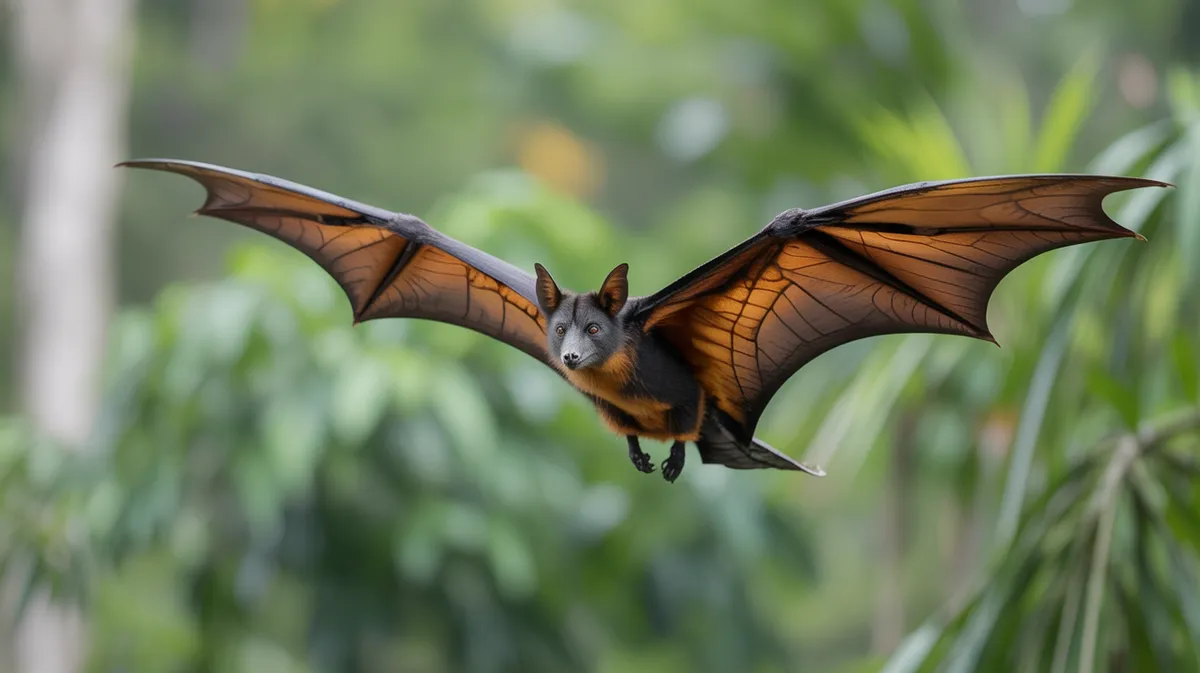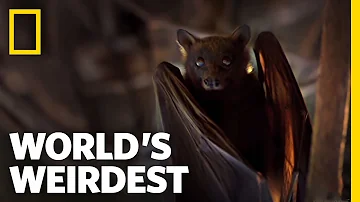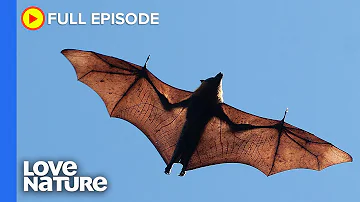
Large Flying Fox
Pteropus vampyrus

Meet the Large Flying Fox
The Large Flying Fox, also known as the Malayan Flying Fox, is one of the largest bat species in the world, notable for its impressive wingspan that can reach up to 1.5 meters. Unlike many bats, it does not use echolocation but relies on its keen sense of sight and smell to locate food, primarily feeding on fruits, nectar, and flowers. These bats play a vital role in their ecosystems as important pollinators and seed dispersers in tropical forests. They roost communally in large colonies, often numbering in the thousands, and are most active at night when they forage for food.
Classification
Mammal
Habitat
Tropical and subtropical forests
Diet
Herbivore
Lifespan
15-30 years
Conservation
Near Threatened
Weight
0.6–1.1 kg
📖Fascinating Facts
Huge Wingspan
The Large Flying Fox boasts one of the largest wingspans of any bat, reaching up to 1.5 meters (almost 5 feet) across.
Key Pollinators
They play a crucial ecological role by pollinating flowers and dispersing seeds, helping maintain healthy forest ecosystems.
No Echolocation
Unlike most bats, Flying Foxes do not use echolocation. They rely on their sharp eyesight and sense of smell to find food.
📋Detailed Description
The Large Flying Fox (Pteropus vampyrus) is among the largest bat species globally, with a wingspan ranging from 1.2 to 1.7 meters (up to 5.6 feet) and a body length of 27–32 cm (10.6–12.6 inches). Adults typically weigh between 600 and 1,200 grams. Its fur is dense and ranges from dark brown to reddish-orange, with a distinctive golden or orange mantle encircling the neck and shoulders. The species possesses a fox-like face with large, forward-facing eyes, an adaptation for its reliance on acute vision. Unlike microbats, it lacks echolocation abilities and instead uses its excellent eyesight and olfactory senses to locate food. Large Flying Foxes are highly social, forming roosts called 'camps' that can number from several hundred to over 10,000 individuals. These bats are primarily nocturnal, emerging at dusk to forage for fruit, nectar, and flowers, often traveling over 50 km in a single night. Their long, strong wings are adapted for sustained flight, allowing them to traverse large distances between fragmented forest patches. The species plays a crucial ecological role as a pollinator and seed disperser, facilitating forest regeneration. Their reproductive rate is low, with females typically giving birth to a single pup per year, making populations vulnerable to decline.
💡 Did you know?
Despite their name and size, Flying Foxes are not related to foxes at all—they are actually fruit bats with fox-like faces.
🔬Research & Sources
Wikipedia Summary
The large flying fox, also known as the greater flying fox, Malayan flying fox, Malaysian flying fox, large fruit bat, kalang, or kalong, is a southeast Asian species of megabat in the family Pteropodidae. Despite its scientific name, it feeds exclusively on fruits, nectar, and flowers, like the other flying foxes of the genus Pteropus. It is noted for being one of the largest bats. As with nearly all other Old World fruit bats, it lacks the ability to echolocate but compensates for it with well-developed eyesight.
Last Modified: 10/16/2024
🎭Behavior & Social Structure
Large Flying Foxes exhibit complex social behaviors, including vocalizations, grooming, and coordinated movement within their colonies. During the day, they roost communally in tall trees, hanging upside down in dense clusters that provide protection from predators and environmental extremes. Social grooming is common and helps reinforce social bonds and reduce parasite loads. At dusk, individuals depart the roost in waves, using visual cues and memory to navigate to fruiting trees, often foraging in groups. Their diet is primarily frugivorous, with a preference for figs (Ficus spp.), mangoes, bananas, and durians, but they also consume nectar and pollen from native flowers, such as those of the durian and kapok trees. Feeding involves chewing fruit to extract juices and pulp, then spitting out the fibrous remains, which aids in seed dispersal. They are known to exhibit site fidelity, returning to the same feeding and roosting sites over time.
👶Reproduction & Life Cycle
Breeding in Pteropus vampyrus is seasonal and varies geographically, but generally peaks during the dry season. Males establish small territories within the roost and may engage in vocal displays and scent marking to attract females. Copulation occurs while hanging from branches. After a gestation period of approximately 140–190 days, females give birth to a single pup, usually between February and May. Twins are rare. Newborns are altricial, with mothers carrying them during foraging flights for the first few weeks. Pups are weaned at about 2–3 months but may remain dependent on the mother for up to 6 months. Sexual maturity is reached at 1.5–2 years. Parental care is exclusively maternal, with no involvement from males after mating.
🛡️Adaptations & Survival
The Large Flying Fox exhibits several key adaptations for its arboreal and volant lifestyle. Its elongated forelimbs and flexible wing membranes (patagia) enable powerful, energy-efficient flight over long distances. The species' large eyes, equipped with a reflective tapetum lucidum, provide excellent night vision. A keen sense of smell aids in locating ripe fruit and nectar sources. Their strong, curved claws allow them to grasp and hang from branches securely. The digestive system is specialized for rapid processing of high-water-content fruit, facilitating quick energy intake and efficient seed dispersal. Behavioral adaptations include communal roosting for thermoregulation and predator avoidance, as well as synchronized foraging to exploit ephemeral fruiting events.
🎨Cultural Significance
Large Flying Foxes hold varied significance in local cultures. In some Southeast Asian communities, they are associated with myths and folklore—often symbolizing mystery, transformation, or longevity. In Indonesia and Malaysia, they are sometimes called 'kalong' and feature in traditional stories. However, they are also hunted for food and traditional medicine, particularly in parts of Indonesia and the Philippines. Their presence in orchards can lead to conflict with farmers, though their ecological role as pollinators and seed dispersers is increasingly recognized in conservation messaging. In recent years, ecotourism focused on bat-watching has emerged as a potential avenue for promoting coexistence and conservation.
🔬Recent Research & Discoveries
Recent research has focused on the ecological role of Pteropus vampyrus in forest regeneration, highlighting their importance in dispersing seeds of both wild and economically valuable fruit trees over long distances. Genetic studies have revealed significant population structuring across their range, suggesting limited gene flow between island populations, which has important implications for conservation management. Ongoing studies are investigating the species' role as a reservoir for emerging infectious diseases, such as Nipah and Hendra viruses, emphasizing the need for integrated One Health approaches. Satellite telemetry and stable isotope analyses have provided new insights into their movement ecology and dietary preferences. Conservation research is increasingly focused on identifying critical roosting and foraging habitats to inform protected area design and management.
🎥Wildlife Videos

Flying Foxes | World's Weirdest
#NatGeoWILD #WorldsWeirdest #Bats About World's Weirdest: A buffalo with three eyes, an exterminator who eats his day's work, ...
Nat Geo Animals

Flying Fox Fairy Tale 🦇| Bat Documentary | Natural History Channel
With a wing span of up to three feet, the Flying Fox is amongst the largest bats in the world. Whilst these bats can be very ...
Banijay Wild

Flying Fox (Bat Family) | Nature's Majestic Fruit Bats
Wildlife Universe

"Flying Fox: Meet the World’s Largest Nature’s Sky Gardener"
Discover the incredible world of the Flying Fox — one of the largest bats on Earth! With a wingspan stretching up to 5 feet, these ...
Rare Wildlife Chronicles

Flying Foxes | Living with Aussie Wildlife | Learn English
Have you ever looked up in the sky at sunset and seen lots of bats flying silently across the sky? These large bats are called ...
SBS On Demand

The World's Biggest Bat | Secrets of Wild Australia Ep104
Flying out of the Australian twilight is one of the most successful mammals on the planet – the bat – and one of the most ...
Love Nature
🌍Habitat Information
The Large Flying Fox typically inhabits Tropical and subtropical forests environments. Large Flying Foxs have adapted to their environments with specialized features and behaviors.
Primary Habitat:
Tropical and subtropical forests
More detailed habitat information will be available soon.
🛡️Conservation Status
The Large Flying Fox is currently classified as Near Threatened. Conservation efforts are crucial for preserving this species for future generations.
Common Threats:
- 🏠Habitat loss and fragmentation
- 🌡️Climate change impacts
- 🎯Hunting and poaching
- 🏭Human-wildlife conflict
⚠️Threats & Conservation Challenges
Pteropus vampyrus faces significant threats from habitat loss due to deforestation, agricultural expansion, and urbanization throughout Southeast Asia. Hunting for bushmeat and traditional medicine, as well as persecution due to perceived crop damage, has led to dramatic population declines in many regions. Large-scale roost disturbances and culling further exacerbate these pressures. The species is also susceptible to disease outbreaks, including zoonotic viruses, which can be exacerbated by close contact with humans and livestock. Climate change poses additional risks by altering fruiting patterns and increasing the frequency of extreme weather events. Current IUCN assessments list the species as Endangered, with ongoing population declines observed across much of its range.
🔬Scientific Classification
Scientific Name
Pteropus vampyrus
Classification Hierarchy
🔍 About Taxonomic Classification
Taxonomic classification is a hierarchical system used by scientists to classify and organize living organisms based on shared characteristics and evolutionary relationships.
The system moves from broad categories (Kingdom) to increasingly specific ones, with each animal's scientific name typically consisting of its Genus and species.
📝Community Notes
Share your observations and insights about the Large Flying Fox with our community of wildlife enthusiasts.
Join Our Community
Sign in to share your observations and connect with fellow wildlife enthusiasts.
Sign In to ContributeNo community notes yet
Be the first to share your observations about the Large Flying Fox!
Explore Large Flying Fox
Select a tab above to learn more about this amazing animal.
📸Photo Gallery
No photos available for this animal yet.
🌟Discover More Wildlife
Continue your journey of discovery with more fascinating animals from our database
